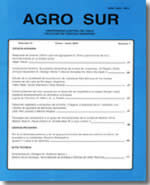EFECTO DE NIVELES DE NITRÓGENO Y DENSIDADES DE POBLACIÓN EN LOS RENDIMIENTOS DE LOS PRIMEROS AÑOS DE UNA ESPARRAGUERA
Main Article Content
Abstract
Nitrogen fertilization in asparagus has been studied using plant populations of around 22.000 plants per hectare, not having information of its use in higher populations, which is the tendency nowadays. Results for the first four years of harvest of a trial that employs two plant densities (22.222 and 44.444 pl/ha) and five levels of N (0, 50, 100, 150 and 200 kg/ha) are analyzed.
Total and commercial yield of the traditional plant density (22.222 pl/ha), for the first four years of harvest, were not statistically lower than that for the higher population, except for the third season; nevertheless, if for the four year period the general average yield is considered, the higher plant density gave higher total and commercial yields both for weight and number of spears. Similarly, the number of spears and yield per plant increased through the seasons with the lower plant population; likewise, with the higher population they seem to diminish in the fourth harvest, showing an apparent effect of plant competition.
Response to nitrogen fertilization was similar for both plant populations tending to lower yields, both in number and weight of spears, when the nitrogen rate applied was over 100 kg/ ha, what would indicate that plant density in asparagus is not a factor of higher N demand.

